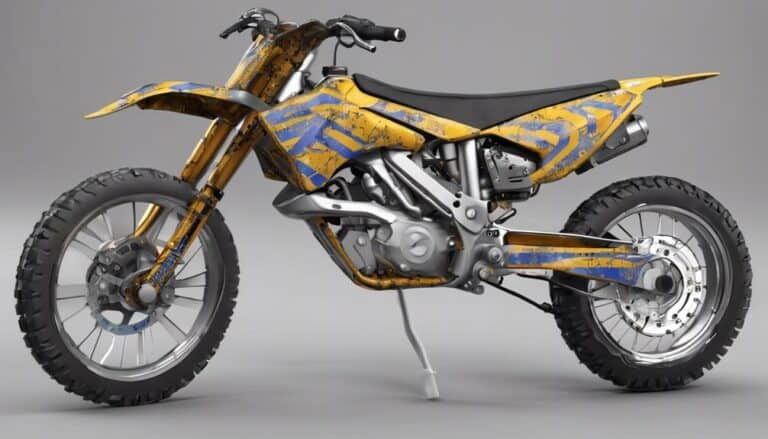To check your dirt bike's electrical system wiring and connections: visually inspect wires for damage, especially around the battery and ignition; make sure connections are secure and free from corrosion. Verify wire colors against a diagram. Confirm tightness of connections and use zip ties for organization. Examine connectors for any issues. Utilize a multimeter for continuity testing. Ground the probe and test wires for a beep. Inspect battery terminals for dirt or corrosion. Tighten terminals securely and apply dielectric grease. Test electrical components for continuity and resistance. Guarantee wires are intact and connections are functional.
Key Takeaways
- Visual inspection for wire damage and wear.
- Ensure secure wire connections without corrosion.
- Test continuity using a multimeter for faults.
- Verify battery terminals for tightness and cleanliness.
- Test electrical components for proper function.
Visual Inspection of Wires
When examining the electrical system wiring on your dirt bike, carefully inspect all wires for any signs of damage or wear. Begin by checking the wires connected to the battery, ignition system, and charging system.
Look for fraying, melting, or exposed wires, as well as any burnt spots or discoloration which could indicate overheating or short circuits. Make sure that the wire connections are secure and free from corrosion to maintain proper power flow.
Confirm that the wire colors match the wiring diagram for correct circuit connections. Utilize a multimeter to measure voltage at various points in the system to verify that power is flowing correctly.
Checking Connection Security
To guarantee the reliability of your dirt bike's electrical system, thoroughly examine the security of all wire connections to prevent potential electrical issues. Make sure all wire connections are tight and secure to avoid any interruptions in electrical flow.
Organize and secure wires using zip ties or clamps to prevent them from getting tangled or interfering with moving parts. Inspect connectors for any signs of corrosion, dirt, or damage that could disrupt proper voltage flow.
Look out for exposed wires or frayed insulation, as they can lead to short circuits or electrical failures. To confirm everything is in order, perform a multimeter test on the connections to verify continuity and proper voltage levels.
Testing Continuity With Multimeter
Begin by setting your multimeter to the continuity test mode, typically indicated by a sound or a diode symbol. To test for continuity in your dirt bike's electrical system, connect one probe to a known good ground point on the bike, such as the frame, and touch the other probe to the wire or connection you want to test. If there is a good connection, you will hear a continuous beep or see a '0' reading on the multimeter. However, if there is a lack of continuity, indicated by no sound or a high resistance reading, this suggests a faulty wire or connection that needs to be addressed.
| Action | Procedure | Expected Result |
|---|---|---|
| Set multimeter | Change setting to continuity mode. | Sound/diode symbol |
| Connect probe | Attach one probe to a known good ground point. | Secure connection |
| Test wire/connection | Touch the other probe to the wire or connection. | Continuous beep/'0' reading |
| Check for continuity | Listen for beep or check multimeter reading. | Good connection |
| Identify issues | No sound or high resistance reading indicates a faulty wire/connection that needs attention. | Faulty wire/connection |
Verifying Battery Terminals
Examine the battery terminals on your dirt bike for any signs of corrosion, dirt, or loose connections that may disrupt the electrical flow. To guarantee peak performance, follow these steps:
- Use a battery terminal cleaner to remove any corrosion or debris, promoting a clean contact surface for efficient electrical flow.
- Securely tighten the terminal bolts to prevent intermittent power loss, maintaining a stable connection between the battery and the electrical system.
- Confirm the polarity when connecting the terminals to safeguard the electrical components from potential damage due to incorrect wiring.
After cleaning the terminals, consider applying a thin layer of dielectric grease to prevent future corrosion and enhance the longevity of the connections.
Testing Electrical Components
When testing the electrical components of your dirt bike, make sure to use a multimeter to check continuity and resistance in wires and connections. Proper testing guarantees that the electrical system functions efficiently. Start by examining the wires for any signs of damage, such as melted insulation or exposed wiring. Using the multimeter, test the continuity of the wires to confirm there are no breaks that could disrupt the flow of electricity. Additionally, check the resistance in the wires to verify they are within the appropriate range for your bike's electrical system.
The table below outlines key steps to test electrical components effectively:
| Step | Description |
|---|---|
| Inspect Connections | Look for loose or corroded connections that may hinder conductivity |
| Check Wire Gauge | Confirm proper wire gauge to prevent overheating or short circuits |
| Examine Plugs | Inspect plugs for damage that could impact the charging system |
| Test Insulation | Ensure insulation integrity to prevent electrical shorts |
Conclusion
To summarize, by visually examining wires, confirming connection security, testing continuity with a multimeter, validating battery terminals, and testing electrical components, you can guarantee the wiring and connections in your dirt bike's electrical system are in proper working order.
This systematic approach will assist you in diagnosing any issues and making necessary repairs, keeping your dirt bike running smoothly and efficiently.
Remember, diligence in maintenance leads to longevity in performance.

